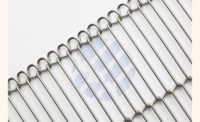Food processors of poultry, pork, seafood, vegetables and cheese products that are breaded or battered utilizing conveyors need wire belting that can withstand the rigors of the process. However, traditional round balance weave belting has changed little in 100 years and is notorious for requiring replacement in as little as a week, causing costly production downtime and excess wasted product.
Food-grade balance weave belts – made of steel or stainless steel, suitable to be run in a conveyor with a sprocket drive, friction drive, or chain driven belt – can cost thousands of dollars, depending on the dimensions and quality. So, even though wear and premature replacement is a serious issue, such wire belting should not be considered simply a low-cost consumable item.
“If the conveyor’s wire belt gets plugged up with batter or breading or if it gets stretched out, you usually have to replace the whole belt,” says a maintenance supervisor who has worked in various food processing facilities serving wholesale and retail markets for over 30 years. As such, he has overseen conveyor belt installation and replacement and maintained equipment for a wide range of food products including breaded or battered chicken, fish, cheese and vegetables.
The maintenance supervisor describes the traditional wire belt longevity challenge as he observed it while working at a food manufacturer of breaded appetizers.
“The sprockets where the belt goes around the drive would build up with breading. The breading would stretch the belt until it broke, usually in about a week. So, production was often stopped for at least 45 minutes to change out the belt,” he explains.
Additionally, in the food processing industry, after coating a product, too often excess breading, batter, or seasoning gets “carried over” to the next processing station (often a fryer) and wasted – instead of falling through openings in the wire belt and then reused.
Fortunately, industry innovation in the form of engineered, “shaped” wire belt has minimized these challenges. The design vastly prolongs usable life with increased strength and decreased stretch, which dramatically curtails production downtime and replacement costs.
In addition, this approach enables a significantly greater amount of surplus coating, such as batter, breading or spice, to fall through the wire belt openings to be re-used. As a result, this lowers production cost even further.
Resolving the Core Issues
Although conventional round wire belt has been the industry standard for generations, the geometry of the wire itself contributes to the problem.
Traditional round and even top-flattened wire belt presents a rather narrow opening for any given wire gauge, which makes it more difficult for excess breading or batter to fall through the opening to be reused. Such belting is usually predisposed to “blinding” of its openings. This can hasten breading or batter build up and the clogging of conveyor sprockets, leading to belt stretch and the need for premature replacement.
In testing, typical round and top flattened conveyor wire belt have been observed to stretch approximately 7%. Such belt stretch is typically the biggest cause for failure on sprocket-driven conveyor belts. When the belt stretches, the sprocket teeth do not engage evenly and will begin to jump the teeth, damaging the belt and sprockets in short order.
Even though many producers of conveyor wire belt simply import semi-finished product and finish it domestically, at least one U.S.-based manufacturer has gone to the root of the problem.
The solution, it turns out, is to engineer “shaped” wire that is designed to provide more strength and open area in wire belt of a given diameter. This not only significantly prolongs its usable life up to 8 times or more, but also facilitates the cost-effective reuse of the excess breading, batter, and seasoning that falls through the wire openings.
As an example, one engineered wire belt, called Sidewinder by Lancaster, PA based Lumsden Belting, a manufacturer of metal conveyor belts for industries such as food processing, compresses and expands wire so it is taller than it is wide with flat sides.
To begin with, the patented side flattened wire’s “I-beam” design provides 3 times greater structural support for food industry product compared to standard round wire. The added height of the wire also provides a longer wear life without needing heavier wire. Together, the design limits belt stretch to only 1-2%.
When the food manufacturer of breaded appetizers turned to the shaped wire belt, the results dramatically improved longevity.
“Where the traditional belt would last about one week, the shaped Sidewinder belt would last about two months,” says the maintenance supervisor.
Later, at processing plants at different companies processing breaded chicken and fish, he says the shaped wire similarly enhanced usable belt life.
“The results were excellent, and the heavier the breading or batter the more the design extended belt life,” he says.
In terms of design, shaping the wire into taller thinner spirals than standard enhances the open area. So, food processors can utilize the same wire gauge of their current belt and gain more open area while lasting longer. Or they can increase the wire diameter to make an even stronger belt without sacrificing the critical open area.
The flattened sides of the wire also reduce the “carry over” issue, which otherwise invariably leads to coating product waste. With a minimum curvature at the top and bottom of each wire loop there is less surface area for expensive coating to contact. So, the flat sides of the shaped spiral allow any spare coating to fall through without clogging openings.
“With the Lumsden side flattened wire belt, there is greater open area with narrower wire for the same wire diameter. So, any extra coating can drop through and be reused,” explains the maintenance supervisor.
While the cost of the shaped wire belt is slightly more than traditional round wire, the gains in production and lifespan make ROI very quick, according to the maintenance supervisor.
“The side shaped wire belt lasts much longer than anything else out there and does not stretch out so you get higher production with less downtime and fewer headaches. With a larger opening for the same wire gauge, recovering and reusing any extra coating also adds to the bottom line,” he concludes.
For more information, visit www.lumsdencorp.com.








